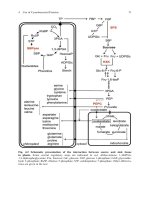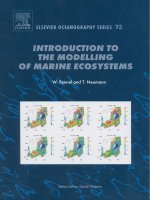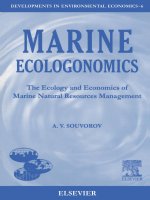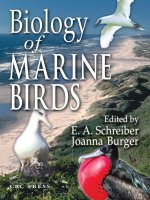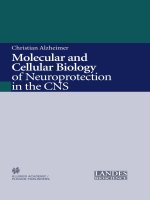Biology of marine birds
Bạn đang xem bản rút gọn của tài liệu. Xem và tải ngay bản đầy đủ của tài liệu tại đây (9.94 MB, 741 trang )
Biology
of
Marine
Birds
9882_frame_FM Page 2 Tuesday, July 3, 2001 3:48 PM
COVER PHOTOGRAPHS
Front Cover
(clockwise from top right)
Red-tailed Tropicbird (R.W. Schreiber)
Great Frigatebird (R.W. Schreiber)
Laysan Albatross — Adult protecting young chick (R.W. and E.A. Schreiber)
Back Cover
(top to bottom)
Shy albatrosses (H. Weimerskirch)
White tern with fish in its bill (E.A. Schreiber)
Masked Booby adult with chick (R.W. and E.A. Schreiber)
Jackass Penguin pair with young (R.W. and E.A. Schreiber)
Biology
of
Marine
Birds
Edited by
E. A. Schreiber
Joanna Burger
CRC
Marine Biology
SERIES
Peter L. Lutz, Editor
CRC PR E S S
Boca Raton London New York Washington, D.C.
9882_frame_FM Page 4 Tuesday, July 3, 2001 9:39 AM
Senior Editor: John Sulzycki
Project Editor: Naomi Lynch
Marketing Manager: Carolyn Spence
Cover Designer: Shayna Murry
Library of Congress Cataloging-in-Publication Data
Biology of marine birds / edited by Elizabeth A. Schreiber and Joanna Burger.
p. cm. — (CRC marine biology)
Includes bibliographical references (p. ).
ISBN 0-8493-9882-7 (alk. paper)
1. Sea birds. I. Schreiber, Elizabeth Anne. II. Burger, Joanna. III. Series.
QL673 .B53 2001
598.177—dc21
2001025898
CIP
This book contains information obtained from authentic and highly regarded sources. Reprinted material is quoted with
permission, and sources are indicated. A wide variety of references are listed. Reasonable efforts have been made to publish
reliable data and information, but the author and the publisher cannot assume responsibility for the validity of all materials
or for the consequences of their use.
Neither this book nor any part may be reproduced or transmitted in any form or by any means, electronic or mechanical,
including photocopying, microfilming, and recording, or by any information storage or retrieval system, without prior
permission in writing from the publisher.
All rights reserved. Authorization to photocopy items for internal or personal use, or the personal or internal use of specific
clients, may be granted by CRC Press LLC, provided that $1.50 per page photocopied is paid directly to Copyright Clearance
Center, 222 Rosewood Drive, Danvers, MA 01923 USA. The fee code for users of the Transactional Reporting Service is
ISBN 0-8493-9882-7/01/$0.00+$1.50. The fee is subject to change without notice. For organizations that have been granted
a photocopy license by the CCC, a separate system of payment has been arranged.
The consent of CRC Press LLC does not extend to copying for general distribution, for promotion, for creating new works,
or for resale. Specific permission must be obtained in writing from CRC Press LLC for such copying.
Direct all inquiries to CRC Press LLC, 2000 N.W. Corporate Blvd., Boca Raton, Florida 33431.
Trademark Notice: Product or corporate names may be trademarks or registered trademarks, and are used only for
identification and explanation, without intent to infringe.
Visit the CRC Press Web site at www.crcpress.com
© 2002 by CRC Press LLC
No claim to original U.S. Government works
International Standard Book Number 0-8493-9882-7
Library of Congress Card Number 2001025898
Printed in the United States of America 1 2 3 4 5 6 7 8 9 0
Printed on acid-free paper
9882_frame_FM Page 5 Tuesday, July 3, 2001 9:39 AM
Dedication
for
Ralph W. Schreiber, Gary A. Schenk, and Michael Gochfeld
For a lifetime of challenges, collaboration, stimulating discussions, and
companionable fieldwork with the seabirds we love.
9882_frame_FM Page 6 Tuesday, July 3, 2001 9:39 AM
9882_frame_FM Page 7 Tuesday, July 3, 2001 9:39 AM
Preface
The field of seabird ornithology has developed dramatically in recent years, partially owing to the
application of new technology to this diverse group of birds. For instance, the advent of satellite
tracking studies has helped us learn about an aspect of seabirds that was unknown previously —
their lives at sea. Because of this we now have a much better knowledge of the energy budgets of
adults and what energetic constraints they experience. Another factor that has limited our ability
to understand the lives of marine birds is their long life span. Without information spanning at least
one generation of individuals, there are many facets of the life history of seabirds that are difficult
to impossible to interpret. But, for seabirds, a generation can be 20 to 30 years, longer than most
ornithological studies on any species. Over the past 20 to 30 years, however, some excellent longterm studies have been carried out. Our aim with the present work is to provide an examination
and summary of the research on seabirds, and also to provide a guide to the relevant literature for
those desiring further information.
This book discusses and summarizes our current knowledge of the biology of marine birds
today. It provides information on the biology, ecology, physiology, evolution, behavior, environmental threats, and conservation of marine birds. It also provides information on key questions for
researchers to address, and for public policy makers involved in management of coastal lands and
marine reserves. We felt that marine birds needed to be examined from a wider perspective: not
only that of the biologist, but also that of those who are concerned about conservation, management,
and public policy. We provide the basis for understanding the biology of marine birds, as well as
their role in and relationship to coastal and oceanic ecosystems.
We explore all facets of the lives of the four main orders of seabirds, examining their fossil
history, taxonomy, distribution, life histories, population dynamics, foraging behavior, nesting
ecology, physiology, energetics, the effects of pollution and other human activities on the birds,
and needs for conservation. Each chapter presents the basics of our current knowledge about that
topic and many chapters also include a guide to yet unanswered questions and suggestions of
potential research paths.
Once into the project we realized that an entire book could be written about each topic we had
selected as a chapter. However, we were required to limit the length of each chapter, and to include
only the most important information and examples. The literature section for each chapter is
extensive and provides an overview of the subject for researchers, conservationists, managers, and
policy-makers.
We also faced the difficulty of defining marine birds (or seabirds; see Chapter 1). While some
orders contain birds that almost entirely live in coastal and marine environments, others do not.
Moreover, some birds not usually considered “marine” spend a great deal of their time in coastal
environments (herons, egrets, some shorebirds), and we have included separate chapters on these
groups, highlighting their marine lives.
We have included three chapters on conservation issues: Chapter 15 (Effects of Chemicals and
Pollution on Seabirds), Chapter 16 (Interactions between Fisheries and Seabirds), and Chapter 17
(Seabird Conservation). As man’s influence reaches the most remote parts of the world, our effect
on seabirds’ lives is increasing. Every aspect of seabird biology and ecology is affected. Many
seabird colonies have been extirpated already and others are disappearing as human development
and disturbance expand. Researchers have estimated that seabird populations today are 10% or less
of what they were a thousand years ago before humans reached many islands (Steadman et al.
1984, Pregill et al. 1994). As the human population expands, invading seabird nesting habitats, we
9882_frame_FM Page 8 Tuesday, July 3, 2001 9:39 AM
are going to see the extinction of many species unless we can learn to value this resource, learn to
coexist, and have the science to effect conservation measures.
While the fossil origins of marine birds are not certain, we do know that they enjoy a worldwide
distribution today, from the poles to the tropics, and from urban coasts to remote oceanic islands.
And there are ornithologists studying them in all these habitats: some of us wear multiple layers
and try to take measurements with heavy gloves on while conducting Arctic field work, and others
wear shorts while enjoying the tropics. Our field studies often take us away from home for extended
periods and we continually try to outthink birds as we devise new ways to accomplish our research
goals. We frequently have to invent our own equipment — from capturing devices, to weighing
scales, to temperature probes, or to adapting new cutting edge technologies to fit our needs. Studying
seabirds can be a daily excursion or a seasonal expedition, and can involve hours driven by car or
days flown by air. All the authors of these chapters are active field researchers working on seabirds.
As you read you can try to imagine the thousands, or perhaps millions, of hours of field work the
knowledge in this book represents, and, for most seabird species, we have only begun. The field
is open, with many, many possibilities for new studies. As soon as we think we have found the
answer to a question, some bird does it differently, so we are forced to use words like most,
sometimes, maybe, often, generally — words you will see used often in this text. But that’s part
of what keeps the discovering fascinating.
In reviewing the chapters, we find that there is important research that needs to be conducted
on nearly every group of seabirds, in all aspects from basic breeding biology and communication
to contaminants. Effects of long-term phenomena such as El Niño–Southern Oscillation events and
global warming on seabird biology and their evolution are difficult to study, making our task that
much more challenging. The task for managers and policy-makers will be to translate the biology
detailed in this book into action to enhance breeding populations, protect nesting and foraging
seabirds, reduce adverse interactions between human activities and seabirds, and enhance the
opportunities for people to study and watch seabirds, thereby ensuring their continued survival.
We feel particularly privileged to have worked with such a superb group of our colleagues in
creating this book. They were all dedicated, responsive, a pleasure to work with, and, we believe,
have created an exceptional volume. We know that the quality of our work herein was significantly
increased by the dedicated reviewers, who, in spite of their busy schedules, took time to provide
thoughtful insight and feedback: Keith Bildstein, Claus Bech, Glen Fox, Mike Gochfeld, David
Goldstein, William Montevecchi, David Nettleship, Storrs Olson, Robert Ricklefs, Peter Stettenheim, Causey Whittow, and all those who must remain anonymous.
E.A. Schreiber
Joanna Burger
Chapter opening drawings by John P. Busby
9882_frame_FM Page 9 Tuesday, July 3, 2001 9:39 AM
Acknowledgments
Between us, we have conducted over 60 years of research on marine birds. During this time, we
have had fruitful discussions with many people too numerous to acknowledge. However, several
people have profoundly influenced our thinking and our research, including C. Beer, J. Coulson,
J. Diamond, M. Erwin, G. Fox, R. W. Furness, J. Hickey, G. L. Hunt, J. Jehl, J. Kushlan, J. Mills,
B. Nelson, D. Nettleship, I. C. T. Nisbet, R. E. Ricklefs, J. Rodgers, C. Safina, J. Saliva, S. Senner,
J. Spendelow, N. Tinbergen, H. B. Tordoff, D. Warner, and G. E. Woolfenden.
There are no words to adequately thank the three people who have influenced our thinking,
challenged our ideas, and conducted field work with us on a variety of seabirds throughout our
careers: Michael Gochfeld, Gary Schenk, and Ralph Schreiber. They will continue to mold our
thinking for years to come. Gary Schenk and Michael Gochfeld spent long hours in fruitful
discussions about seabirds, organization of this book, assisting in preparation of Appendix 2, and
many other preparation details. They were drafted in a hundred ways, and this volume is a tribute
to their knowledge and love of seabirds, not to mention us. We thank our editor, John Sulzycki, at
CRC Press for shepherding the manuscript through the process, and for understanding that deadlines
are meant to encourage progress. We also thank the editor of the series, Peter Lutz, for seeing the
importance of highlighting marine birds in this marine series.
Over the years, we have received support from a number of organizations, and we thank them.
EAS thanks the American Association of University Women Educational Foundation, Defense
Nuclear Agency, Giles W. and Elise G. Mead Foundation, National Science Foundation (OCE8308756, OCE-8404152), the National Geographic Society, Los Angeles County Museum of
Natural History, and the National Museum of Natural History, Smithsonian Institution. JB thanks
the American Association of University Women Educational Foundation, National Institute of
Mental Health, National Institute of Environmental Health Sciences (ESO 5022, 5955), National
Science Foundation, U.S. Environmental Protection Agency, National Oceanographic and Atmospheric Adminstration, U.S. Fish & Wildlife Service, Consortium for Risk Evaluation with Stakeholder Participation (CRESP) through the Department of Energy (AI #DE-FC01-95EW55084, DEFG 26-00NT 40938), the Endangered and Nongame Species Program of New Jersey Department
of Environmental Protection, and Institute for Coastal and Marine Sciences and the Environmental
and Occupational Health Sciences Institute of Rutgers University.
9882_frame_FM Page 10 Tuesday, July 3, 2001 9:39 AM
9882_frame_FM Page 11 Tuesday, July 3, 2001 9:39 AM
The Editors
E. A. Schreiber is a Research Associate in the Bird Department of the National Museum of Natural
History, Smithsonian Institution. She received her Ph.D. from UCLA, studying breeding biology
and energetics in Red-tailed Tropicbirds. She carries out research on tropical seabirds in many
areas of the world, specializing in studies of their breeding biology, ecology, demography, and
energetics. Her research activities have spanned 30 years and include long-term studies on Christmas
Island (Pacific Ocean) and Johnston Atoll.
In addition to her basic research, Dr. Schreiber serves as an advisor to conservation organizations
in the United States and worldwide on seabird issues, working to promote seabird conservation.
She has published over 50 scientific papers and 3 books on terns, gulls, and conservation issues,
and authored or co-authored 6 “Birds of North America” species accounts on Pelecaniformes and
terns. She has served the professional ornithological community for many years through terms on
the governing boards and councils of the Ornithological Council, the Association of Field Ornithologists, the Pacific Seabird Group, the Cooper Ornithological Society, the Waterbird Society,
and the American Bird Conservancy. Prior to moving to Washington, D.C. in 1994 she was a
Research Associate at the Los Angeles County Museum of Natural History in Los Angeles for 18
years. She recently co-edited with D. S. Lee the “Status and Conservation of West Indian Seabirds”
(Society of Caribbean Ornithology).
Joanna Burger is a Distinguished Professor of Biology at Rutgers University where she teaches
ecology and behavior and ecological risk to undergraduate and graduate students. She is a member
of the Institute for Marine and Coastal Sciences, the Biodiversity Center, and the Environmental
and Occupational Health Sciences Institute. She is an ecologist, behavioral biologist, and ecotoxicologist who has worked with seabirds for over 30 years in many parts of the world. She is a pastpresident for the Waterbird Society. She has served on the New Jersey Governor’s Endangered and
Nongame Species Council since 1980, on the Technical Committee for the Roseate Tern Recovery
Team, on numerous National Research Council Committees, and on the Atlantic States Marine
Fisheries Commission Technical Committee for Horseshoe Crabs, and presently serves on the
NRC’s Commission of Life Sciences. She is on the Editorial Board for Environmental Research,
Science for the Total Environment, Environmental Monitoring and Assessment, and Journal of
Toxicology and Environmental Health. Her research has led to over 300 papers and numerous book
chapters, and she has authored or co-authored six “Birds of North America” accounts on gulls and
terns. She has edited 6 volumes on avian behavior and seabirds, and co-written two books on
behavior of colonial-nesting birds (Common Terns, Black Skimmers). She recently edited The
Commons Revisited: An Americas Perspective (Island Press 2000).
9882_frame_FM Page 12 Tuesday, July 3, 2001 9:39 AM
9882_frame_FM Page 13 Tuesday, July 3, 2001 9:39 AM
The Contributors
Patricia Herron Baird
Kahiltna Research Group
Department of Biological Sciences
California State University
Long Beach, California, USA
P. Dee Boersma
Department of Zoology
University of Washington
Seattle, Washington, USA
Joël Bried
Groupe Ecologie Comportementale
Centre National de la Recherche Scientifique
Centre d'Ecologie Fonctionnelle et Evolutive
Montpellier, France
M. de L. Brooke
Department of Zoology
University of Cambridge
Cambridge, UK
Joanna Burger
Distinguished Professor of Biology
Division of Life Sciences
Environmental and Occupational Health
Sciences Institute
Institute of Marine and Coastal Sciences
Rutgers University
Piscataway, New Jersey, USA
J. Alan Clark
Department of Zoology
University of Washington
Seattle, Washington, USA
John C. Coulson
St. Mary’s Close
Durham, UK
Hugh I. Ellis
Department of Biology
University of San Diego
San Diego, California, USA
Chris Elphick
Department of Ecology and Evolutionary
Biology
University of Connecticut
Storrs, Connecticut, USA
Peter C. Frederick
Department of Wildlife Ecology and
Conservation
University of Florida
Gainesville, Florida, USA
Geir W. Gabrielsen
Norwegian Polar Institute
Tromsø, Norway
Michael Gochfeld
Professor of Medicine
Environmental and Community Medicine
Environmental and Occupational Health
Sciences Institute
UMDNJ-Robert Woods Johnson Medical
School
Piscataway, New Jersey, USA
David L. Goldstein
Department of Biological Sciences
Wright State University
Dayton, Ohio, USA
Keith C. Hamer
Department of Biological Sciences
University of Durham
Durham, UK
Nigella Hillgarth
Tracey Aviary
Department of Biology
University of Utah
Salt Lake City, Utah, USA
9882_frame_FM Page 14 Tuesday, July 3, 2001 9:39 AM
Pierre Jouventin
Groupe Ecologie Comportementale
Centre National de la Recherche
Scientifique
Centre d'Ecologie Fonctionnelle et
Evolutive
Montpellier, France
William A. Montevecchi
Biophysiology Programme
Memorial University of Newfoundland
St. Johns, Newfoundland, Canada
J. Bryan Nelson
Reader Emeritus
Aberdeen University
Aberdeen, Scotland, UK
Margaret A. Rubega
Department of Ecology and Evolutionary
Biology
University of Connecticut
Storrs, Connecticut, USA
E. A. Schreiber
Research Associate
National Museum of Natural History
Smithsonian Institution
Washington, D.C., USA
David A Shealer
Department of Biology
Loras College
Dubuque, Iowa, USA
G. Henk Visser
Zoological Laboratory and Centrum voor
Isotopen Onderzoek
University of Groningen
Groningen, The Netherlands
Kenneth I. Warheit
Wildlife Research Division
Department of Fish and Wildlife
Olympia, Washington, USA
Nils Warnock
Point Reyes Bird Observatory
Stinson Beach, California, USA
Henri Weimerskirch
Centre d’Etudes Biologiques de Chizé
Centre National de la Recherche Scientifique
Villiers en Bois, France
G. Causey Whittow
Professor and Chairman
Department of Physiology
J. A. Burns School of Medicine
University of Hawaii
Honolulu, Hawaii, USA
9882_frame_FM Page 15 Tuesday, July 3, 2001 9:39 AM
Table of Contents
Chapter 1
Seabirds in the Marine Environment ...........................................................................1
E. A. Schreiber and Joanna Burger
Chapter 2
The Seabird Fossil Record and the Role of Paleontology in Understanding
Seabird Community Structure....................................................................................17
Kenneth I. Warheit
Chapter 3
Seabird Systematics and Distribution: A Review of Current Knowledge ................57
M. de L. Brooke
Chapter 4
Colonial Breeding in Seabirds ...................................................................................87
John C. Coulson
Chapter 5
Seabird Demography and Its Relationship with the Marine Environment .............115
Henri Weimerskirch
Chapter 6
Foraging Behavior and Food of Seabirds ................................................................137
David A. Shealer
Chapter 7
Climate and Weather Effects on Seabirds................................................................179
E. A. Schreiber
Chapter 8
Breeding Biology, Life Histories, and Life History–Environment Interactions
in Seabirds ................................................................................................................217
Keith C. Hamer, E. A. Schreiber, and Joanna Burger
Chapter 9
Site and Mate Choice in Seabirds: An Evolutionary Approach..............................263
Joël Bried and Pierre Jouventin
Chapter 10 Seabird Communication and Displays.....................................................................307
J. Bryan Nelson and Patricia Herron Baird
Chapter 11 Energetics of Free-Ranging Seabirds.......................................................................359
Hugh I. Ellis and Geir W. Gabrielsen
Chapter 12 Seabird Reproductive Physiology and Energetics ...................................................409
G. Causey Whittow
Chapter 13 Chick Growth and Development in Seabirds ..........................................................439
G. Henk Visser
9882_frame_FM Page 16 Tuesday, July 3, 2001 9:39 AM
Chapter 14 Water and Salt Balance in Seabirds.........................................................................467
David L. Goldstein
Chapter 15 Effects of Chemicals and Pollution on Seabirds .....................................................485
Joanna Burger and Michael Gochfeld
Chapter 16 Interactions between Fisheries and Seabirds ...........................................................527
William A. Montevecchi
Chapter 17 Seabird Conservation................................................................................................559
P. Dee Boersma, J. Alan Clark, and Nigella Hillgarth
Chapter 18 Shorebirds in the Marine Environment....................................................................581
Nils Warnock, Chris Elphick, and Margaret A. Rubega
Chapter 19 Wading Birds in the Marine Environment...............................................................617
Peter C. Frederick
Appendix 1: List of Seabird Species.............................................................................................657
Appendix 2: Table of Seabird Species and Life History Characteristics .....................................665
Index...............................................................................................................................................687
9882_frame_FM Page 17 Tuesday, July 3, 2001 9:39 AM
9882_frame_FM Page 18 Tuesday, July 3, 2001 9:39 AM
Courting Red-tailed Tropicbirds
9882_frame_C01 Page 1 Tuesday, July 3, 2001 8:49 AM
1
Seabirds in the Marine
Environment
E. A. Schreiber and Joanna Burger
CONTENTS
1.1 Introduction...............................................................................................................................1
1.2 Why Are Seabirds Different? ...................................................................................................4
1.3 Colonial Living.........................................................................................................................9
1.4 Adaptations and Lifestyles of Marine Birds..........................................................................10
1.5 Looking to the Future.............................................................................................................11
Literature Cited ................................................................................................................................12
1.1 INTRODUCTION
Marine birds are equally at home on land, in the air, and in the water. While many organisms can
go from land to water (amphibians, some reptiles, some insects), others generally live in only one
medium during their lives. Marine birds switch from one to the other, often daily. Such flexibility
requires unique physiological and morphological adaptations to the environment, a medium that
has also exerted selective forces on the behavior, ecology, and demography of these birds. Amazingly, marine birds have adapted to essentially all environments on the earth, from those able to
survive winters in Antarctica to those who can sit for days incubating their eggs in the tropical sun.
Trying to learn about and explain this diversity may be why we find the study of them so fascinating:
How does their structure and function interact with the marine environment to produce their
particular life histories?
There is no one definition of marine birds or seabirds. For this book, we define marine birds
as those living in and making their living from the marine environment, which includes coastal
areas, islands, estuaries, wetlands, and oceanic islands (Table 1.1). But many Charadriiformes
(shorebirds) and Ciconiiformes (erons, egrets, ibises) that feed near shore or along the coastlines
are generally not considered to be true seabirds. Seabirds are a subset of the birds in Table 1.1,
those that feed at sea, either nearshore or offshore; this excludes all the Ciconiiformes and the
shorebirds from the Charadriiformes. The one common characteristic that all seabirds share is that
they feed in saltwater, but, as seems to be true with any statement in biology, some do not.
In this book we have attempted to provide a thorough examination of the biology of seabirds:
all the Sphenisciformes and Procellariiformes, all the Pelecaniformes except anhingas, and all the
Charadriiformes except shorebirds (Figure 1.1). Because we felt the book should be useful to land
managers, public policy-makers, and conservationists (who must knowledgeably manage our
quickly disappearing wetlands and estuaries), we have included gulls as seabirds (although few go
to sea) and also summary chapters on wading birds (Ciconiiformes) and shorebirds. These birds
are particularly dependent on nearshore habitat for both feeding and nesting.
Seabirds exemplify one of the reasons for man’s fascination with birds — the ability to fly and
live so far from the mainland. They are among the most aerial of birds, able to spend weeks,
0-8493-9882-7/02/$0.00+$1.50
© 2002 by CRC Press LLC
1
9882_frame_C01 Page 2 Tuesday, July 3, 2001 3:50 PM
2
Biology of Marine Birds
TABLE 1.1
Marine Birds Include Birds in the Following Orders
Order
Sphenisciformes
Procellariiformes
Ciconiiformes
Pelecaniformes
Charadriiformes
Types of Birds
Penguins
Albatrosses, petrels, storm-petrels, fulmars, shearwaters
Herons, egrets, storks, ibis, spoonbills
Pelicans, frigatebirds, gannets, boobies, cormorants, anhingas
Shorebirds, skuas, jaegers, gulls, terns, skimmers, auks, guillemots, puffins
Note: The Ciconiiformes, anhingas, shorebirds, and skimmers are not considered to be seabirds.
(a)
(b)
FIGURE 1.1 Representatives of the four major seabird orders: (a) Sphenisciformes: King Penguins incubating
their eggs on their feet; (b) Procellariiformes: a Wedge-tailed Shearwater on Midway Island; (c) Pelecaniformes: a Brown Pelican incubates its three eggs; (d) Charadriiformes: a Blue Noddy on Christmas Island.
(Photos a and b by J. Burger; c and d by E. A. Schreiber.)
9882_frame_C01 Page 3 Tuesday, July 3, 2001 8:49 AM
Seabirds in the Marine Environment
3
(c)
(d)
FIGURE 1.1 Continued.
months, and, in some cases, even years at sea. This habit of spending long periods at sea, out of
sight of land, has also made them among the most difficult of bird species to study and understand.
Much of their life is spent where we cannot observe or study them, although this is changing with
advances in technology such as satellite transmitters that are light enough to be carried by a bird.
Although the open ocean seems to us to be a uniform environment, a tremendous diversity of
seabirds has evolved to feed in this environment in a great variety of ways. Such diversity suggests
that the marine environment is not as homogeneous as we once thought, at least to the organisms
that live there. The apparent uniformity was reflected in our inability to detect and measure the
heterogeneity. We now know that the seas vary on seasonal cycles as well as stochastically and
spatially (see Chapters 6 and 7). We are not as at home on the ocean as seabirds and have learned
to take lessons from birds. Mariners often relied on seabirds to tell them they were near land, while
fishermen today still rely on feeding flocks to help locate schools of fish. Mutiny on Columbus’
voyage to the New World was thwarted by seabirds: when the crew finally saw feeding flocks of
seabirds, they knew they were close to land (Couper-Johnston 2000).
9882_frame_C01 Page 4 Tuesday, July 3, 2001 8:49 AM
4
Biology of Marine Birds
TABLE 1.2
Comparison of Characteristics of Seabirds and Passerines
Life History Characteristic
Seabirds
Passerines
Age of first breeding
Clutch size
Incubation period
Nestling/fledging period
Maximum life span
2–9 years
1–5
20–69 days
30–280 days
12–60 years
1–2 years
4–8
12–18 days
20–35 days
5–15 years
1.2 WHY ARE SEABIRDS DIFFERENT?
Seabirds have dramatically different life-history characteristics, or demography, from most land
birds, such as members of the order Passeriformes (Table 1.2). In fact, their life history characteristics are often referred to as extreme: long life (20 to 60 years), deferred maturity (breeding age
delayed to up to 10 years of age), small clutch size (in many cases one egg), and extended chickrearing periods (often up to 6 months). Passerine birds, in comparison, have shorter lives and larger
clutches of eggs, and chicks grow to fledging age much faster. Seabirds also tend to be larger than
land birds, less colorful in plumage, and sexually monomorphic. Plumage colors of seabirds are
mainly white, gray, black, or brown, or some combination thereof, another area that needs research.
Basically the two life styles exemplified by seabirds and passerines represent two different
ways to accomplish the same end: leave enough offspring to replace yourself in the population.
Red-footed Boobies (Sula sula) commonly live 16 years, begin reproducing (one young per year)
at 3 years of age, and 35 to 40% of their young survive to reproduce (Schreiber et al. 1996). A
pair thus has the potential to produce about five breeding offspring (birds), although there are
generally a few failed breeding seasons owing to the occurrence of El Niño events (see Chapter
7). More coastal species, such as Black Skimmers (Rynchops niger), live for about the same time
and are capable of raising two or three young a season, but colonies can also fail completely in
some years due to heavy rains and thermal stress (Burger and Gochfeld 1991; see Chapter 7).
Robins (Turdus migratorius), a typical passerine, commonly live 3 years, first lay at 1 year of age
(lay an average of four eggs), and can raise two broods in some years; about 20% of their young
survive to reproduce (Sallabanks and James 1999). So in a lifetime they can raise about five young
that survive to reproduce. They also can have failed years when no young are produced, but it is
less likely to occur throughout a whole region as it does in seabirds.
Why have these two very different lifestyles evolved? They may reflect conditions imposed on
seabirds by living in the marine environment (Ashmole 1963, Lack 1968), and also conditions
imposed on land birds by predation (Slagsvold 1982). Seabirds may not have been exposed to
predation historically, although the human introduction of mammalian predators to both coastal
and oceanic islands has been a major source of mortality for seabirds that did not evolve with this
threat (Moors and Atkinson 1984, Burger and Gochfeld 1994).
Early hypotheses on the reasons for the life-history characteristics of seabirds have come to be
called the “energy-limitation hypotheses.” David Lack (1968) proposed that seabirds’ unusual
demography evolved owing to energetic constraints on adults’ ability to supply food to chicks.
Birds feeding at sea were viewed as randomly searching a vast area for patchily distributed food
that then had to be caught and carried long distances back to a colony. Philip Ashmole (1963) also
suggested that dense aggregations of birds in one area, such as in seabird colonies, depressed local
food resources, causing density-dependent limitations on breeding and nest success (Figure 1.2).
He proposed that seabirds were perhaps over-fishing the area around colonies and adults could not
find enough food to raise more young or faster-growing young. Specifically then, small clutch sizes
and slow growth of young were considered to be adaptations to an imposed low rate of food delivery
9882_frame_C01 Page 5 Tuesday, July 3, 2001 8:49 AM
Seabirds in the Marine Environment
5
FIGURE 1.2 Cape Gannets (South Africa) are one of the most densely nesting seabirds. Neighbors can easily
peck each other if they have a disagreement and thus much signaling of intentions (behavioral posturing) goes
on to forestall any misunderstanding. Shown is Michael Gochfeld. (Photo by J. Burger.)
to chicks. Additionally, seabird chicks (particularly Procellariiformes) lay down large amounts of
fat during development, which, presumably, was necessary to carry them through periods when
adults could not find enough food (Lack 1968, Ashmole 1971).
These hypotheses have been the driving force behind many studies on seabirds over the past
35 years and, interestingly, they are hypotheses for which it is hard to find support. Their role in
the development of seabird biology was critical. However, as with any discipline, hypotheses change
as we gather more information, and the energy-limitation hypothesis proved particularly difficult
to validate. Some studies do not support the hypotheses, and other studies show that they could be
true. We believe that biologists will never prove one way or the other why seabirds are different
from land birds. It is undoubtedly a combination of selective factors. Indeed, it may be more of a
continuum than we had believed. The discussion that follows is intended to highlight some issues
for future study. It is also necessary to note that marine birds may appear food limited today because
of the rapidly intensifying competition with fisheries and increasing human pressure.
Potential support for the energy-limitation hypothesis comes from clutch size, colony size, and
foraging area comparisons. Seabirds that feed offshore generally have smaller clutches than those
that feed nearshore (Nelson 1983; see Chapter 8). Pelicans, cormorants, gulls, and skimmers feed
primarily nearshore and have average clutches of two to four eggs (see Appendix 2), presumably
because they feed close by, making use of highly productive nearshore and estuarine resources.
Offshore-feeding seabirds, such as albatrosses, petrels, boobies, and some terns, have clutches of
one. Lower clutch size in itself does not prove offshore feeders are energy limited, however.
If there were a correlation between colony size and productivity of local waters, one might
expect the smallest colonies to be in tropical waters away from cold water upwelling areas such
as in the Humboldt Current where food is abundant. There certainly are some very large colonies
in the Humboldt and Benguela Current areas, but there are also large concentrations of breeding
birds in tropical non-upwelling areas such as on Midway Island (approximately one million seabirds;
U.S. Fish and Wildlife Service 1996) and on Christmas Island (an estimated 12 million seabirds;
Schreiber and Schreiber 1989), both in the central Pacific.
If adults are energy limited, you might expect to see populations with high mortality rates of
growing chicks when feeding conditions deteriorate at all. There is little evidence for this occurring.
Nest success rates in seabird colonies on oceanic islands are frequently on the order of 75% or
greater, and failed nests are often those of young, inexperienced birds (see Chapter 8). Years with
9882_frame_C01 Page 6 Tuesday, July 3, 2001 8:49 AM
6
Biology of Marine Birds
FIGURE 1.3 Multispecies assemblages of breeding seabirds often have overlapping diets, foraging zones,
and foraging methods, raising the question of the significance of competition in their evolution. Least Auklets
(left) and Parakeet Auklets often nest in colonies (around the Alaskan coast) with several other species. (Photo
by J. Burger.)
high chick mortality occur infrequently, and are generally associated with an unusual weather
occurrence such as an El Niño event, when starvation of chicks occurs because of a disappearance
of, or great reduction in, the food source (see Chapter 7; Schreiber and Schreiber 1989).
If adults are limited in their ability to provide food to chicks because of an irregular or
unpredictable food supply, daily feeding rates of young should be sporadic and irregular. As you
might expect, with the great diversity of seabird species, there is some evidence on both sides of
this prediction. Some studies of feeding rates of chicks found that chicks are fed on a more regular
basis than expected by chance alone and that fat stores are not needed for periods of fasting (Taylor
and Konarzewski 1989, Navarro 1992, Hamer 1994, Hamer and Hill 1994, Cook and Hamer 1997,
Schreiber 1994, Reid et al. 2000). Other studies have found a degree of unpredictability in food
delivery which indicates fat reserves may be useful in carrying a chick through lean times (Hamer
et al. 2000). Reid et al. (2000) suggested that fat stores in albatross chicks may have evolved to
carry chicks through fledging while they learn to feed themselves.
Dense aggregations of breeding seabirds trying to raise hungry young might be expected to
over-fish an area, but there is little evidence for this happening, and it would be difficult to prove.
With high nest success rates (in non-El Niño years) in some very huge seabird colonies, such as
that on Christmas Island (Central Pacific Ocean), it appears that birds may not over-fish an area
(Schreiber and Schreiber 1989). Birt et al. (1987) found some inconclusive evidence for prey
depletion around a colony of Double-crested Cormorants (Hypoleucos auritus).
A possible indication that food supply is an energy-limiting factor would be the evolution of
the reliance on separate food sources in sympatrically breeding species as a way to avoid competition
for the resource (Figure 1.3). Ornithologists have reconciled the discrepancy between high reproductive success and limited food resources by claiming that seabirds are partitioning the food
resource by either taking different prey species, foraging in different areas, or breeding at different
times of the year. However, there is little direct support for this. Ashmole and Ashmole (1967)
found a large degree of overlap in the species and sizes of fish and squid taken by eight tropical
seabird species breeding on Christmas Island (central Pacific). There is also extensive overlap in
the size of fish and squid taken by the Pelecaniform species nesting on Johnston Atoll (central
Pacific; E. A. Schreiber unpublished). In both locations, breeding seasons of the nesting seabirds
overlap extensively. Large overlap in the prey base has been found in other studies (Whittam and
